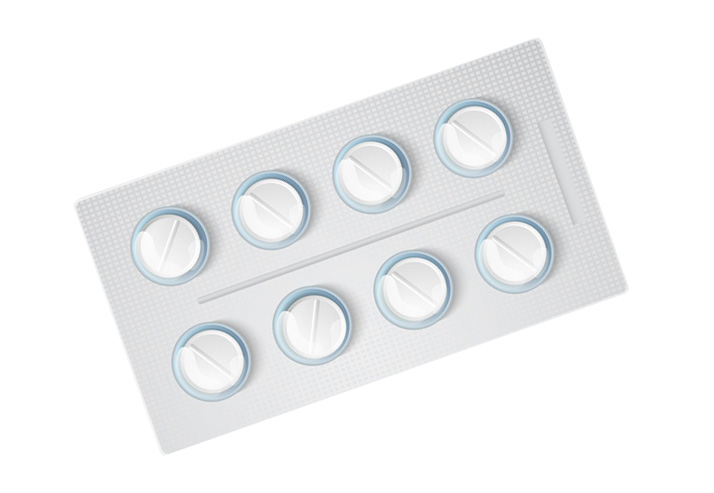Rulide
Indications for Rulide are based on the antibacterial activity and pharmacokinetic characteristics of roxithromycin.
They take into account both the clinical studies conducted with this medicine and its place in the range of antibacterial products currently available.
They are limited to infections caused by germs defined as sensitive:
- Documented angina caused by beta-haemolytic streptococcus A, as an alternative to treatment with beta-lactam antibiotics, particularly when the latter cannot be used;
- Acute sinusitis. Based on the microbiological characteristics of these infections, macrolides are recommended when treatment with a beta-lactam antibiotic is not feasible;
- Superinfections of acute bronchitis;
- Exacerbations of chronic bronchitis.
Community-acquired pneumonia in subjects:
- without risk factors,
- without indications of clinical severity,
- in the absence of clinical features suggestive of pneumococcal aetiology.
For suspected cases of atypical pneumonia, macrolides are recommended regardless of the severity or patient history.
- Benign skin infections: impetigo, impetiginisation of dermatoses, ecthyma, infectious dermohypodermatitis (in particular erysipelas), erythrasma.
- Non-gonococcal genital infections.
Forms and Strengths

Scored tablet for drinkable suspension.
10 tablets in blister packs (Aluminium/Aluminium) + spoon.
16 tablets in blister packs (Aluminium/Aluminium) + spoon.
How To Take
Dosage
The dosage is 5 to 8 mg/kg/day in 2 oral doses (the average dose used in paediatric clinical trials was 6 mg/kg/day).
Depending on the child's weight:
- Children from 6 to 11 kg: 1/2 tablet morning and evening
- Children from 12 to 23 kg: 1 tablet morning and evening
- Children from 24 to 40 kg: 2 tablets morning and evening.
Treatment should not be prolonged beyond 10 days.
For sore throats, the treatment period is 10 days.
Method of administration
Place the half-tablet or tablet in the spoon in the pack, filled with water, and wait 30 to 40 seconds for the tablet to disintegrate.
What happens next
Administer the suspension to the child and then have him or her drink a little water.
Rulide should preferably be taken before meals.
Side Effects
Possible adverse reactions to Rulide:
- Superinfection
- C.difficile colitis
- Pseudomembranous colitis
- Eosinophilia
- Thrombocytopenia
- Neutropenia
- Agranulocytosis
- Hypersensitivity reaction
- Allergic urticaria
- Angioedema
- Bronchospasm
- Anaphylactoid reaction
- Anaphylactic shock
- Hallucination
- Confusional state
- Dizziness
- Headache
- Paresthesia
- Agueusia
- Dysgeusia
- Parosmia
- Anosmia
- Nausea
- Vomiting
- Gastralgia
- Diarrhoea
- Bloody diarrhoea
- Pancreatitis
- Jaundice
- Cholestatic hepatitis
- Cytolytic hepatitis
- Skin rash
- Bullous reaction
- Erythema multiforme
- Stevens-Johnson syndrome
- Lyell syndrome
- Purpura
- Angioedema
- Acute generalised exanthematous pustulosis
- Increase in transaminases
- Increased alkaline phosphatase
- Transient deafness
- Hypoacusis
- Labyrinthine vertigo
- Tinnitus
- Visual disorders
- Blurred vision
- Prolongation of the QT interval
- Ventricular arrhythmia
- Torsades de pointes
- Ventricular tachycardia
- Ventricular fibrillation
- Cardiac arrest
Contraindications
- Breast-feeding if the child is being treated with cisapride
- lactose intolerance
- Severe hepatic impairment
- Pregnancy
- Patients over 15 years of age
- Patients less than 1 month old
This medicinal product must never be used in the following situations:
allergy to macrolides or to any of the excipients.
Association with:
- ergot alkaloids, vasoconstrictors: dihydroergotamine, ergotamine,
- colchicine,
- cisapride.
Precautions
- Mild to moderate hepatic impairment
- Manifestations of severe cutaneous reaction
- Severe cutaneous reaction
- Congenital long QT syndrome
- Patients with pro-arrhythmogenic conditions
- Myasthenia
- Diarrhoea following antibiotic treatment
- Breast-feeding
Special warnings
Excipients with a notable effect
This medicinal product contains lactose. Its use is not recommended in patients with galactose intolerance, Lapp lactase deficiency or glucose-galactose malabsorption syndrome.
Hepatic insufficiency
In patients with severe hepatic impairment, Rulide is not recommended. In mild to moderate hepatic impairment, roxithromycin should be used with caution. If administration is necessary, regular monitoring of liver tests should be carried out and the dosage reduced if necessary.
Impaired renal function
Renal elimination of the active compound and its metabolites is low (10% of the oral dose), so dosages should not be altered in patients with renal impairment.
Elderly patients
There is no need to adjust the dose in elderly patients.
Duration of treatment
As abnormalities of the conjugation cartilage have been observed in young animals at doses at least 10 times higher than therapeutic doses, it is recommended that the dosage be limited to 5-8 mg/kg/day for a maximum period of 10 days.
Association with ergot alkaloids
Severe vasoconstriction (ergotism) with possible necrosis of the extremities has been reported with macrolides in association with vasoconstrictive ergot alkaloids. Before prescribing Rulide, it is necessary to check that patients are not being treated with these alkaloids.
The concomitant use of Rulide with dopaminergic ergot alkaloids is not recommended.
Severe bullous reactions
Cases of severe bullous reactions such as Stevens-Johnson syndrome, Lyell syndrome and acute generalised exanthematous pustulosis (AGEP) have been reported with Rulide. If the patient develops symptoms or signs of AGEP, Stevens-Johnson or Lyell syndrome (e.g. progressive skin rash often with blistering or mucosal lesions), Rulide should be discontinued.
Precautions for use
Prolongation of the QT interval
Under certain conditions, macrolides, including roxithromycin, have the potential to prolong the QT interval. Therefore, Rulide should be used with caution in patients with congenital long QT syndrome, pro-arrhythmic conditions (e.g. uncorrected hypokalaemia or hypomagnesaemia, clinically significant bradycardia), as well as in patients receiving class IA and III anti-arrhythmic drugs and other treatments that may prolong the QT interval such as hydroxychloroquine or chloroquine.
Myasthenia
Like other macrolides, Rulide can exacerbate myasthenia gravis.
Clinical monitoring in the event of prolonged treatment
Monitoring of liver function, renal function and blood count is recommended, particularly in the event of prolonged treatment (e.g. duration of treatment exceeding 2 weeks).
Clostridium difficile infection
Clostridium difficile-associated diarrhoea (CDAD) has been reported with virtually all antibiotics. Their severity may range from mild diarrhoea to life-threatening pseudomembranous colitis. Treatment with antibiotics alters the flora of the colon, leading to excessive proliferation of C. difficile.
C. difficile releases toxins A and B, which lead to the development of CDAD. Strains producing these toxins heighten morbidity and mortality since such infections may resist antibiotic treatments and may necessitate colectomy. Any patient who experiences diarrhea after using antibiotics should be evaluated for CDAD, and the antibiotic Rulide should be stopped immediately. It's crucial to consider this diagnosis in patients who develop diarrhea during or after receiving antibiotics.
Interactions
Contraindicated combinations
Colchicine
Increased adverse effects of colchicine, with potentially fatal consequences.
Cisapride
Increased risk of ventricular rhythm disorders, particularly torsades de pointes.
Ergotamine, dihydroergotamine
Ergotism with possible necrosis of the extremities (reduced hepatic elimination of ergotamine and inhibition of hepatic elimination of dihydroergotamine).
Combinations not recommended
Dopaminergic ergot alkaloids (bromocriptine, cabergoline, lisuride, pergolide)
Increase in dopaminergic plasma concentrations, with possible increase in activity or appearance of signs of overdose.
Drugs likely to cause torsades de pointes
This serious heart rhythm disorder can be caused by a number of drugs, both anti-arrhythmic and non-arrhythmic. Hypokalaemia (particularly induced by hypokalaemic drugs) is a favourable factor, as is bradycardia (particularly induced by bradycardia-inducing drugs) or pre-existing prolongation of the QT interval, whether congenital or acquired. The drugs responsible for this undesirable effect include class Ia and III antiarrhythmics and certain neuroleptics. Other drugs not belonging to these classes may also be implicated.
Increased risk of ventricular rhythm disorders, particularly torsades de pointes.
Clinical and electrocardiographic monitoring during combination.
Combinations subject to precautions for use
Bradycardia drugs
Increased risk of ventricular rhythm disorders, particularly torsades de pointes.
Clinical and electrocardiographic monitoring.
Antivitamin K (acenocoumarol, fluindione, phenindione, warfarin)
Increased effect of antivitamin K and risk of haemorrhage. More frequent monitoring of INR. Dosage of antivitamin K may need to be adjusted during and after treatment with macrolide.
Hydroxychloroquine or chloroquine
Rulide should be used with caution in patients treated with these drugs known to prolong the QT interval, due to the possibility of inducing serious cardiovascular adverse effects (including QT interval prolongation, cardiac arrhythmias and torsades de pointes) and increasing the risk of cardiovascular mortality.
Specific problems of INR imbalance
Numerous cases of increased activity of oral anticoagulants have been reported in patients receiving antibiotics. The patient's infectious or inflammatory background, age and general condition appear to be risk factors. In these circumstances, it appears difficult to distinguish between the infectious pathology and its treatment in the occurrence of INR imbalance.
Atorvastatin, simvastatin
Increased risk of concentration-dependent adverse reactions such as rhabdomyolysis.
Use lower doses of cholesterol-lowering drugs.
Ciclosporin
Risk of increased ciclosporin blood concentrations and creatinemia.
Blood levels of ciclosporin should be measured, renal function monitored and dosage adjusted during the combination and after discontinuation of the macrolide.
Digoxin and other digitalis
Increase in digoxinemia due to increased absorption.
Clinical monitoring (symptomatology and ECG monitoring) and possibly digoxinemia monitoring during treatment with azithromycin and after its discontinuation.
Clinical monitoring is mandatory if symptoms suggesting digitalis overdose occur. Digitalis toxicity in the heart may be manifested by the following symptoms: nausea, vomiting, diarrhoea, headache or dizziness, cardiac rhythm or conduction disorders.
Combinations to be taken into account
Midazolam
Slightly increased sedation.
Theophylline (and, by extrapolation, aminophylline)
Risk of increase in theophyllinemia, particularly in children. However, this does not generally require a change in the usual dosage.
Rulide is a weak inhibitor of 3A CYP4. It can reduce the elimination of drugs metabolised mainly by CYP3A by up to 2-fold. Caution should be exercised when roxithromycin is co-prescribed with a drug metabolised by CYP3A (such as rifabutin and bromocriptine).
Not applicable.
Pregnancy and Breastfeeding
As a precautionary measure, Rulide should not be used during pregnancy. Clinical data are insufficient, although animal data show no evidence of malformative or foetotoxic effects at doses in excess of 200 mg/kg/d or 40 times the therapeutic dose in humans.
The passage of most macrolides into breast milk has been documented, with concentrations in milk equal to or greater than plasma concentrations. However, the quantities ingested by the newborn remain low compared with paediatric doses. The major risk is a change in the child's intestinal flora. Breast-feeding is therefore possible. If digestive problems occur in infants (intestinal candidiasis, diarrhoea), breast-feeding (or the drug) should be discontinued.
If cisapride is taken by a newborn or breast-fed infant, the administration of macrolides to the mother is contraindicated as a precautionary measure, due to the potential risk of interaction in the child.



